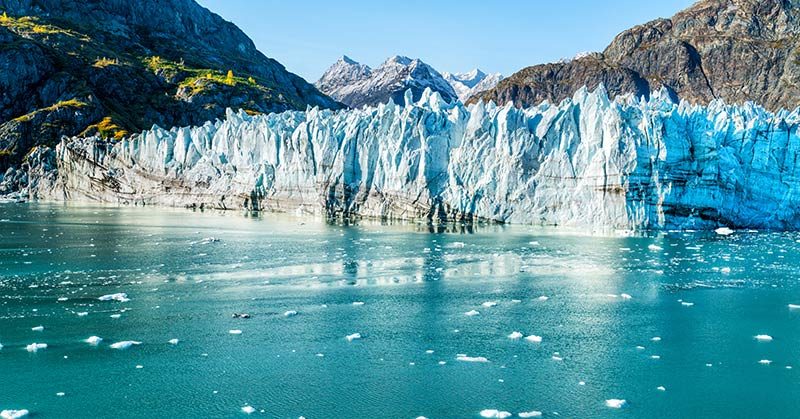Another mega-tsunami is brewing in Alaska, and it could happen sooner than we think. Scientists warn that this catastrophic event could occur in the next two decades – and even within the next 12 months. (1)
Alaskan Ice Melt To Cause a Mega Tsunami
A landslide of rock has been left unstable because of glacier melting in Prince William Sound, Alaska. Scientists are warning that this landslide could suddenly give way, causing a mega-tsunami bigger than we’ve ever seen before. (1)
The group wrote an open letter to the Alaska Department of Natural Resources (ADNR) in May outlining the details of this impending event. In their letter, they made it quite clear that while many of the details about how and when this event will take place are still unknown, one thing is for sure: It will happen, and we need to be prepared. (1)
The Cause of the Mega Tsunami
This unstable mountain slope is located 60 miles east of Anchorage, sitting right above the bottom tip of Barry Glacier in Barry Arm. As climate change continues to cause the melting of permafrost, this slope has a high potential to fail and collapse suddenly into Barry Arm. (1)
“When the climate changes, the landscape takes time to adjust,” said geologist and letter co-author Bretwood Higman. “If a glacier retreats really quickly it can catch the surrounding slopes by surprise – they might fail catastrophically instead of gradually adjusting.” (2)
This sudden drop will generate a mega-tsunami that could potentially threaten the lives of hundreds of people all at once. (1) These people include (1):
- Tourists
- Fishing vessels
- Hunters
This area, while remote, is frequented by fishing boats and Alaskan cruise ships. (2)
They Speak from Experience
The reason for their urgency is because this is not the first time something like this has happened. (1)
In October 2015, a slow-moving landslide in Taan Fiord in Icy Bay, Alaska, failed suddenly and caused a mega-tsunami. This tsunami reached 633 feet in elevation near the landslide and 35 feet in elevation 15 miles away. (1)
In June 2017 at Karrat Fjord in West Greenland, a landslide produced a similar tsunami. It destroyed a large portion of the town of Nuugaatsiaq 20 miles away and killed four people. Over three years later and the villagers still can’t return because of a nearby slope that is also threatening to fail. (1)
According to the scientists, the unstable slope in Barry Arm is much larger than both of those and will cause a devastating impact in Prince William Sound. (1)
What Causes Slopes to Become Unstable
There are several reasons why slow-moving landslides can change suddenly and fail without much warning. They are often preceded by rockfalls and other signs of instability. (1) These triggers include (1):
- Heavy or prolonged rain
- Earthquakes
- Hot weather causing the melting of permafrost, snow, or glacier ice
The scientists have preliminary results to show the potential spread of the Tsunami, saying that they will need to complete further analysis to make more accurate estimates. (1)
They predict (1):
- The most severe effects will be where the landslide hits the water at the top of Barry Arm (the bottom of Barry Glacier).
- Areas further away from the source of shallow water and low-lying land near the shore are in danger.
- Impacts from a minor failure will be contained primarily in the inner parts of the fiord. Should a complete failure happen, impacts will be felt throughout:
- Barry Arm
- Harriman Fiord
- Parts of Port Wells
- Initial results show over 30-foot waves further from the landslide and some distant bays, including in Whittier.
Scientists Need Our Help
The group of researchers is asking locals, tourists, and the ADNR to help them gather information. (1) They would like to know (1):
- What specific questions are most important to them?
- What things are needed to protect the people in Barry Arm and the surrounding area?
- Photos and other documentation of what they have seen in Barry Arm. This includes small rockfalls and landslides.
If you live in or are visiting the area and have either questions or potentially helpful information, it is important to share with local officials and the ADNR. (1)
What They’re Doing Now
Currently, the scientists are working with the ADNR and the Division of Geological and Geophysical Survey (DGGS). They have also reached out to the US Geological Survey asking for help to begin monitoring the situation closely as soon as possible. (1)
Their goal is to make it so that the National Tsunami Warning Center (NTWC) can monitor the landslide. Currently, they only have systems in place to monitor earthquake-generated tsunamis only. (1)
So far this project is funded and run by volunteers and other supporting groups. Two of these groups are the Alaska Climate Adaptation Science Center and NASA. (1)
Keep Reading: Japan reportedly will dump Fukushima’s contaminated water into sea

